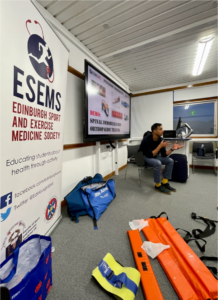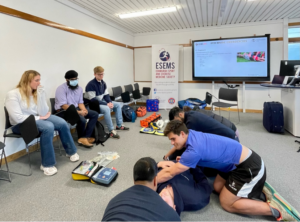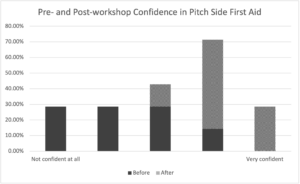Keywords: Sports medicine, training, education
Sport & Exercise Medicine: neglected in medical school?
Sport & Exercise Medicine (SEM) has grown as a specialty since integration into the UK National Health Service (NHS). SEM combines internal medicine, physical activity for health and musculoskeletal medicine to play a key role in tackling inactivity and multi-morbidity. Yet although the introduction of postgraduate training programmes has been widespread, this has not been reflected in the undergraduate experience (1,2). Doctors graduate from UK universities having experienced an average of only 4.5 hours of SEM teaching, and the majority lack competency in explaining the current guidelines for physical activity (3-5). This blog describes the experience of an undergraduate SEM society with suggestions on how collaboration and peer-led education can help bridge the gap to postgraduate practice.
A decade in collaboration and peer-led SEM education
Edinburgh Sport & Exercise Medicine Society (ESEMS) was formed in 2013 to increase access and exposure to SEM for undergraduate medical students, appealing to students from diverse backgrounds. Guest speakers, teaching workshops, competitions and conferences have been hosted each year, and their steady growth in popularity is likely attributable to a focus on addressing specific gaps in SEM in University programmes (6).
Opportunities in hospital, academic, and sporting environments were considered lacking by members, and in response the society established relationships with the burgeoning Scottish SEM community. Engagement with organisations including the Scottish Rugby Union and Scottish Institute of Sport has facilitated clinical experience, and the Fitness Assessment & Sports Injuries Centre and Physical Activity for Health Research Centre at the University of Edinburgh support the research opportunities..
The society hosted the national Undergraduate Sport & Exercise Medicine Conference in 2017 and will host the 2022 iteration Pitch Side to Rehabilitation: a Multidisciplinary Approach. A link to sign up is here. The event will address SEM topics including field-of-play care, injury management, rehabilitation and return to participation. Such events stimulate cooperation with other societies, introduce internationally-renowned speakers, and help students transition towards a postgraduate model of continued professional development.
Year in review
The 2021/22 year provided challenges related to COVID-19 and social restrictions. The academic programme began with online SEM Careers events that introduced SEM and described the experiences of four speakers at different stages of their development. The event considered opportunities for early clinical exposure for junior students, portfolio and career-building for more established trainees, and presented broad lessons from clinicians at the top of the SEM field.
Research in SEM was introduced by speakers involved in the academic aspects of public health, physical activity, and sports-based physiology, and time was dedicated to pursuing further education through SEM-related intercalated degrees. Central to these events was the facilitation of peer-led experience-sharing and the development of a community of students that has been under-represented amongst more established specialty interests.
Educational activity continued with interactive SEM in Performance Sports workshops. A Pitchside Emergencies session introduced the principles of managing acutely unwell athletes and practical considerations while working in a pre-hospital environment. (Figure 1[a] and 1[b]). An Exercise Prescription session considered the empirical evidence behind physical activity guidelines and outlined approaches to prescribing using motivational interviewing techniques. Then a Drugs in Sport workshop handled the concept of doping and saw attendees engaging in a lively debate about the principles of fairness and integrity in competition, the clinician’s duty of care to athletes, and the pursuit of excellence at the apex of elite sport.

Figure 1(a). ESEMS Pitchside Emergencies Workshop

Figure 1(b). ESEMS Pitchside Emergencies Workshop.
Is this approach effective?
Qualitative and quantitative feedback was collected to ensure the needs of attendees were being met by our educational programme. Just over half of students felt that SEM concepts were not covered adequately in their undergraduate programme, and the majority agreed that additional teaching was necessary to address the shortfall in a number of areas: exercise prescription; concussion; pre-hospital medicine, and musculoskeletal injuries. Students reported a lack of confidence relating to the field of play care, but this improved significantly following the delivery of relevant workshop-based education, supporting the hypothesis that extracurricular peer-led education can meet the needs of students interested in SEM (Figure 2).

Figure 2. Students’ self-reported knowledge and skills before and after ESEMS Pitchside Emergencies workshop.
The future
Evidence suggests that musculoskeletal medicine – a core tenet of healthy active living – is being eroded from undergraduate curricula, and the last decade has seen little progress in the introduction of SEM into medical schools. (1-3,7,8) Peer-led education will continue to play an important role in bridging this gap. ESEMS has established new links with a local rugby club that will facilitate shadowing in a real-world setting, and our events will help build a community of students pursuing careers in SEM. Most importantly we will continue to advocate for greater representation of SEM in the undergraduate curriculum. We have learned from the challenges and successes of undergraduate SEM societies, and hope our experience may provide insights to other groups.
Authors: Kathryn Greenslade,1 James Nelson,1 Andrew D Murray,2,3,4 Rajeev McCrea-Routray,5 Andrew J Hall1,6,7,8
Affiliations
- College of Medicine & Veterinary Medicine, University of Edinburgh, Edinburgh, UK
- Sport and Exercise Research Group, University of Edinburgh, Edinburgh, UK
- Physical Activity for Health and Research Centre, University of Edinburgh, Edinburgh, UK
- Chief Medical and Scientific Officer, DP World Tour, Wentworth, UK
- Chief Medical Officer, Cricket Scotland, Edinburgh, UK
- PhD Research Fellow, Scottish Hip Fracture Audit, Public Health Scotland, Edinburgh UK
- Chief Resident, Dept of Orthopaedics, Golden Jubilee University National Hospital, Clydebank, UK
- Club Doctor, Heart of Midlothian Football Club, Edinburgh, UK
Conflict of interest: AM serves as an associate editor with BJSM.
REFERENCES
- Vishnubala D, Marino KR, Pratten MK, Pringle A, Griffin SA, Finn G, et al. Integrating sport and exercise medicine clinics into the National Health Service: a qualitative study. BMJ Open Sport Exerc Med. 2020 Nov 3;6(1)
- Vishnubala D, Iqbal A, Marino KR, Salman D, Pringle A, Nykjaer C, et al. Creating a Sport and Exercise Medicine Masters syllabus for doctors: a Delphi study. BMJ Open Sport Exerc Med. 2022 Apr 8; 8(2)
- Radenkovic D, Aswani R, Ahmad I, Kreindler J, Robinson R. Lifestyle medicine and physical activity knowledge of final year UK medical students. BMJ Open Sport Exerc Med. 2019 Jun 1; 5(1)
- Weiler R, Chew S, Coombs N, Hamer M, Stamatakis E. Physical activity education in the undergraduate curricula of all UK medical schools. Are tomorrow’s doctors equipped to follow clinical guidelines? Br J Sports Med. 2012 Nov 1;46 (14):1024–6
- Dunlop M, Murray AD. Major limitations in knowledge of physical activity guidelines among UK medical students revealed: implications for the undergraduate medical curriculum. Br J Sports Med. 2013 Jul 1; 47(11): 718–20
- Osborne S, Adamas JM, Fawkner S, Kelly P, Murray AD, Oliver CW. Tomorrow’s doctors want more teaching and training on physical activity for health. Br J Sports Med. 2016 Oct 24;51:624-5
- Malik-Tabassum K, Lamb JN, Chambers A, West R, Pandit H, Aderinto J. Current State of Undergraduate Trauma and Orthopaedics Training in United Kingdom: A Survey-based Study of Undergraduate Teaching Experience and Subjective Clinical Competence in Final-year Medical Students. J Surg Educ. 2020 Jul 1;77(4):817–29.
- Hall AJ, Hackney RJ, Baird EJ. Advances in digital orthopaedic education: Techniques to enhance learning. J Trauma Orthop. 2021 Dec; 9(4)